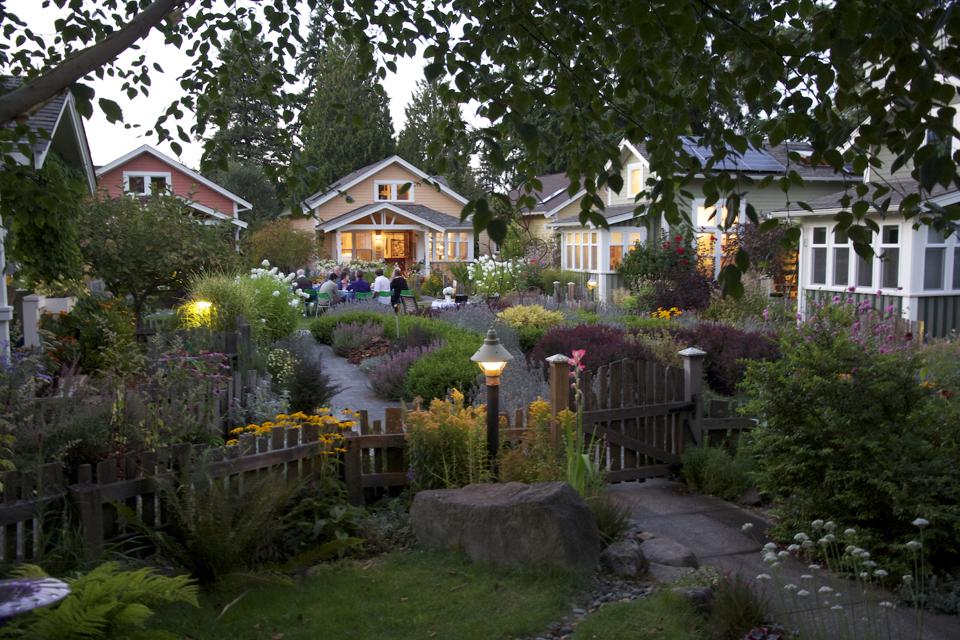
Greenwood Avenue Cottages, designed by Ross Chapin Architects, was built by The Cottage Company in Shoreline, WA, just north of Seattle.
Photo courtesy of Ross Chapin Architects.
Today many people are feeling lost and disconnected. They don’t need a great deal of space, but they would like to feel more connected to their neighbors than they would in a typical community. Unlike years past when many family members lived close by, today family members are scattered in different cities and not near, allowing for regular visits. In addition, many people want a place with green space so they don’t see cars and traffic out of their windows. A wonderful solution to this dilemma is to live in a pocket neighborhood.

Many of the pocket communities have a central area to pick up mail so it creates an opportunity to people to interact. This is The Third Street Cottages in Langley, WA Chapins first such community.
Photo courtesy of Ross Chapin Architects
Pocket Neighborhoods make up small clusters of houses in urban, suburban, or rural settings in which small-footprint homes are arranged around a shared common area. The closeness that is created in these communities encourages interaction among neighbors and is perfect for people who seek a stronger sense of community than is found in a conventional neighborhood. They want a more caring supportive, safer, and connected place to live.

The Concord Riverwalk community is a pocket community in Concord MA made up of 13 cottages.
Photo courtesy of Nat Rea for Prefabulous World, published by Abrams
Although the houses are generally close together, they are designed to ensure privacy with the use of careful window placement and individual gates or gardens that designate private spaces. Parking is usually located away from the individual houses, so residents must walk through the common areas to get to their front doors, offering opportunities for a nod or chat with a neighbor. Some communities, where weather is a major factor, will have attached garages.

This Grow pocket community was built on Bainbridge Island, WA. The houses were designed by architect Jonathan Davis. Many of the houses are powered by solar energy and the community is walking distance from the ferry..
Photo courtesy of Anthony Rich for Prefabulous World, published by Abrams
Ross Chapin, an architect in Langley, Washington first coined the term, pocket Neighborhood. With pressure in the City of Langley, WA for more housing, the town adopted a new zoning code, Cottage Housing Development, to allow for more dense development without sprawling new houses. This new zoning law allows for up to double the density of detached homes in all single-family zones — providing the ground floor area is less than 700 SF and total area including the second floor is less than 975 SF. The houses need to face a common landscaped area and have parking not visible from the street. These projects had to be reviewed by the town planning and review boards before they would be approved. Since this ordinance was established in Langley, WA, similar codes have developed across the United States and Canada, with dozens of new pocket neighborhoods established.

Greenwood Avenue Cottages has front porches, on each cottage, so residents can easily socialize, adding to the friendliness of the community. This community in Shoreline, WA was designed by Ross Chapin.
Photo courtesy of Ross Chapin Architects
Chapin designed the first community with his development partners Jim Soules and Linda Pruitt to take advantage of this new zoning law with the Third Street Cottages in 1996. It included eight cottages, each about 650 SF and with lofts up to 2000SF, a commons building for gatherings, a tool shed, and individual storage units. They surround a shared garden and parking is detached from the houses.
According to Chapin, one of the positive aspects of these communities is that the homes can be smaller. “There is no need for every home to be designed to host a large party one or two times per year, when a large commons room is available. Shared guestrooms in a commons house lessen the need for additional bedrooms in every house.”In addition he notes that come communities have shared cars so every family does not need to have a second or third car.
These communities are ideal for people in many different stages of their life. They offer a connection for older people who might be otherwise lonesome and also for younger people with small families. “In a pocket neighborhood,” Ross says, “a child will find close-by playmates and shirt-tail grandmas, while the parent will be at ease knowing they are in a safe place.”

Greenwood Avenue Cottages with the common areas in the center. These are an important aspect of this type of community.
Photo courtesy of Ross Chapin
However this close proximity can create social problems; therefore Ross encourages developers to include a line item in their budget for a community facilitator. This person can help establish a framework for a healthy and thriving community, assisting with marketing and filtering potential residents, and facilitate early meetings to help them launch and establish a healthy community culture.
Ross notes “there is an epidemic of loneliness in Western culture, due in part from the isolation stemming from living in environments that emphasize privacy and independence over connection. Pocket neighborhoods offer an antidote for people wanting to live in a place where relations among neighbors take place easily in the course of daily life.”
Rosschapin
